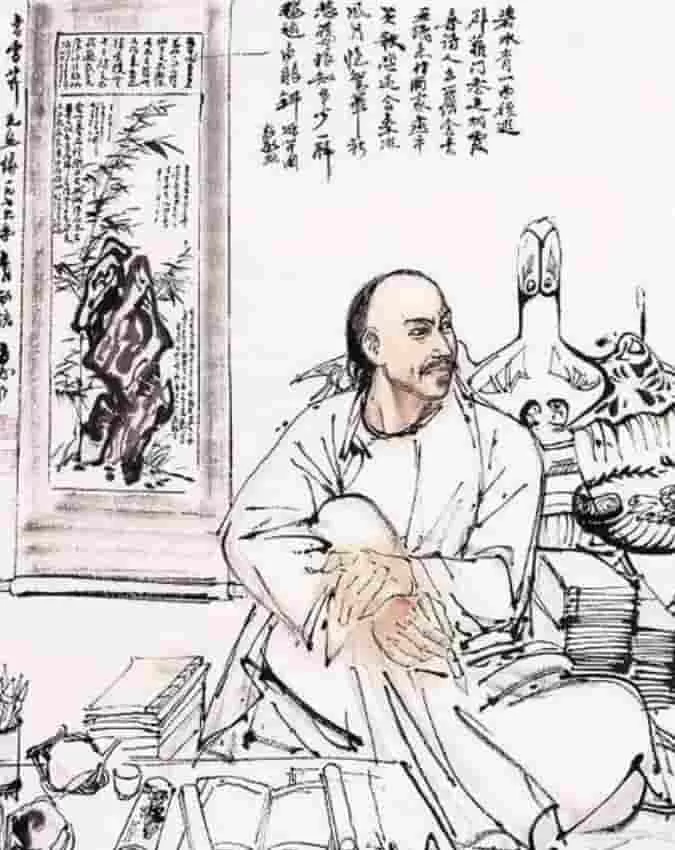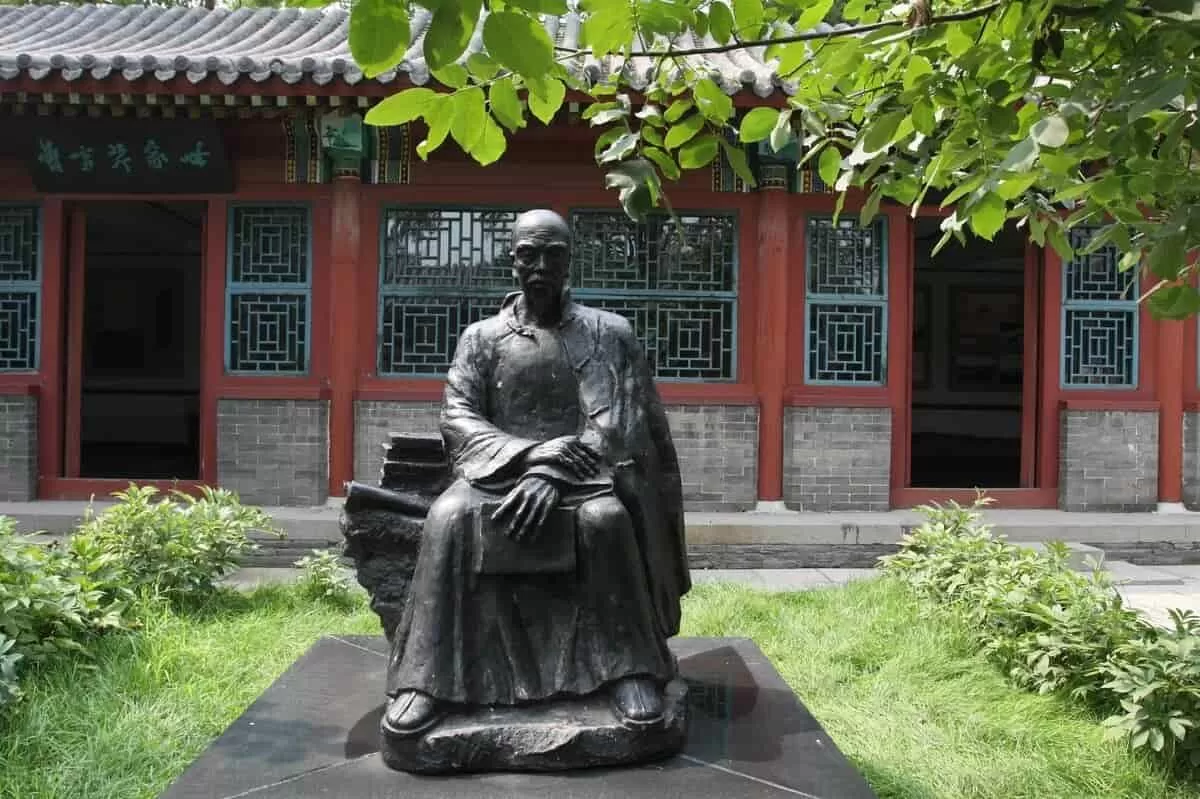
Cao Xueqin (c. 1715–1763; some sources cite 1715–1764), personal name Zhan, courtesy name Mengruan, also known by his art names Xueqin, Qinpu, and Qinxi, was a native of Liaoyang. A novelist, poet, and painter of the Qing Dynasty, he was the grandson of Cao Yin. After dedicating ten years to meticulous revisions through five drafts, he authored the masterpiece Dream of the Red Chamber (also known as The Story of the Stone). This novel, renowned for its profound philosophical depth and intricate narrative, holds a pivotal place in the history of Chinese literature.
Cao spent his youth in Nanjing before relocating to Beijing with his family. His early years were marked by extraordinary wealth and privilege. In 1727, his father Cao Fu was implicated in a scandal, dismissed from office, and had his property confiscated on charges of financial mismanagement, leading to the family's abrupt decline. They subsequently moved to Beijing, where Cao later resided in the city's western outskirts. In his final years, he endured extreme poverty, surviving on meager meals of porridge with his household. Plagued by destitution, he witnessed the death of his wife and child before dying in impoverished circumstances before the age of fifty.
Cao was also an accomplished poet and painter, though most of his works have been lost. Only two fragmented lines from an inscription for Dun Cheng's Legend of Pipa Xing at Baixiang Mountain survive: "Scholar Bai's poetic spirit would surely rejoice, / Commanding even spirits to stage this play." Dream of the Red Chamber stands as Cao Xueqin's monumental contribution to Chinese literature and culture. Rooted in his lived experiences and observations, the novel employs the technique of "veiling truth in fiction" and "rustic tales" to convey his life journey and insights. Its profound themes, poetic narrative, richly drawn characters, and deeply moving plotlines grant it timeless allure. The enduring academic discipline of "Redology" owes its vitality to this enduring classic.
| alias | Cao Xueqin |
| character | Dream Ruan |
| The era in which it is located | Qing dynasty |
| birthplace | Jiangning (now Nanjing) |
| Date of Birth: | Around May 28, 1715 (April 26, 54th year of Kangxi reign) |
| date of death | Around February 12, 1763 (Qianlong Renwu New Year's Eve) |
| Main achievements | Creating the Chinese classical masterpiece 'Dream of the Red Chamber' |
| Main works | The Dream of Red Mansion |
| My real name | Cao Qian |
| Zhai Hao | Mourning Red Pavilion |
| registered residency of Manchus | Imperial Household Department's White Flag Coat |
In the first lunar month of the Kangxi Emperor's 54th year (1715), Cao Yong, then serving as the Textile Commissioner of Jiangning, died of illness while reporting to the throne in Beijing. By imperial grace, the Kangxi Emperor ordered Cao Fu (Cao Yong's cousin) to be adopted into Cao Yin's lineage to inherit the post. On the seventh day of the third lunar month, Cao Fu memorialized: "My sister-in-law née Ma is currently in her seventh month of pregnancy." This posthumously born child was Cao Xueqin, delivered on April 26 (May 28, 1715) at the Jiangning Textile Commissioner's residence in Nanjing.
Days after Cao Xueqin's first-month celebration, on the third day of the sixth lunar month, Cao Fu reported: "Copious rains have graced the land for days, drenching the fields." This inspired Cao's given name "Zhan" (沾, meaning "to moisten"), symbolizing divine favor. The character derives from the Book of Songs: "Abundant clouds bring soaking rains, / Nourishing every grain," conveying "basking in imperial beneficence." His art name "Xueqin" (雪芹, "snow celery") originates from Su Shi's poem: "Mud-rooted celery, one inch remains; / When will snow sprouts stir? Spring doves feast."
Cao Xueqin's great-grandmother served as Kangxi's wet nurse. His grandfather Cao Yin was Kangxi's childhood study companion and imperial guard, later appointed Jiangning Textile Commissioner and Salt Censor of Lianghuai. Across three generations under Kangxi and Yongzheng, the Cao family governed Jiangning Textile Commission for 58 years. Their immense wealth and prestige made them Nanjing's foremost aristocrats, widely regarded as one of the empire's most eminent clans. Kangxi's six southern tours included four receptions hosted by Cao Yin. Cao Xueqin, however, was born too late to witness these events. As evidenced in Dream of the Red Chamber (Chapter 16), even senior characters like Wang Xifeng (older than Jia Baoyu) learned of it through oral accounts from elders like Nanny Zhao.
In the twelfth lunar month of 1727 (Yongzheng 5), thirteen-year-old Cao Xueqin (by East Asian age reckoning) witnessed his uncle—or by some accounts, father—Cao Fu, then Textile Vice-Commissioner of Jiangning, stripped of office and imprisoned on charges including harassing courier stations, deficit in textile commission funds, and diverting assets. Before the Lantern Festival the following January, the family property was confiscated (affecting 114 family members and servants). Cao Xueqin relocated to Beijing with his household, marking the irreversible decline of the Cao family.
Initially, they sustained themselves with seventeen and a half rooms at their old Garlic Market residence outside Chongwen Gate and three pairs of servants. To repay debts from the courier station case and cover living expenses, however, they reluctantly sold land for several thousand taels of silver. Opportunistic servants embezzled portions of the Eastern Estate's rents during this process. As financial shortfalls worsened daily, they resorted to pawning houses and selling land. Thieves burglarized their home, leaving them without daily funds and forcing them to mortgage property deeds. Ultimately, the household scattered, and their estate crumbled "beyond ruinous debris." Cao, silenced by family misfortunes, later reflected: "Though I dare not claim to have endured all bitterness and hardship, I have gained insight into human affairs and worldly ways."
Cao Xueqin's supreme contribution lies in literary creation. His masterpiece Dream of the Red Chamber stands as a monumental work distinguished by its grand scale, meticulous structure, intricate plotlines, and vivid portrayals. It crafts a gallery of archetypal characters, representing the pinnacle of classical Chinese novels while securing a pivotal place in world literature. Cao bequeathed invaluable cultural heritage and spiritual wealth not only to the Chinese nation but to global audiences.
The novel's influence extends far beyond inspiring generations of writers; it has spawned exceptional derivative works across painting, film, television, animation, and video games. Academic and public discourse surrounding its authorship, editions, textual analysis, and historical context has evolved into a dedicated field of study—Redology—solidifying the work's enduring intellectual legacy.
"Born into splendor, perished in desolation." The abrupt collapse of Cao's family—from glorious prosperity to desolate ruin—imbued him with profound sorrow for life's fragility and society's cruelty. Liberated from his former class's vulgarity and prejudice, he perceived the inevitable decline of feudal aristocracy, while simultaneously embracing a sense of disillusioned melancholy. His tragic experiences, poetic sensibilities, intellectual curiosity, and innovative spirit converged in Dream of the Red Chamber.
Cao embodied a paradox: ardent engagement with worldly life alongside transcendental detachment. Neither a misanthrope nor a nihilist, he rejected absolute renunciation of mortal existence. Had he genuinely advocated awakening from "earthly dreams," he would not have wept bitter tears for human suffering nor clung so fiercely to lived realities. Through profound empathy and personal tribulations, he articulated humanity's entanglement in worldly attachments and yearning for liberation—capturing the agony of earthly bonds and the universal longing for transcendence within a contradictory emotional landscape.
The novel's opening chapter features two authorial prefaces. Herein, Cao Xueqin outlines his creative motivations, process, and artistic principles, explicitly critiquing formulaic, didactic literature divorced from reality. He maintains that works rooted in personal truths possess superior authenticity compared to those riddled with "glaring inconsistencies and implausibilities." His own narrative, drawn from "half a lifetime's firsthand observations" of women's lives, adheres scrupulously to genuine human experiences: "In depicting partings and reunions, joys and sorrows, rises and falls, I follow reality without artifice, avoiding contrivances that sacrifice truth for spectacle."
Rejecting historical tropes and folk tales, Cao mined material directly from contemporary social realities—each word "saturated with blood," infused with personal anguish. His "unflinching realism, devoid of euphemism" preserves life's multifaceted complexity. Through intricate character relationships, he exposes aristocratic absurdities, moral bankruptcy, and inexorable decay. Breaking from traditional archetypes where "good characters were wholly virtuous, villains entirely wicked," Cao created "authentic human beings," revolutionizing Chinese fiction by transitioning from stereotypical to individualized, psychologically nuanced portraits.
With a poet's sensitivity, Cao transmuted lived experience into art, consciously crafting lyrical ambiguity—vivid yet elusive. Unlike moralizing predecessors who pronounced verdicts from ideological pulpits, he delved into trembling souls, inscrutable psyches, and life's unavoidable bitterness. His work invites readers to savor existence's manifold flavors, transforming narrative into an immersive meditation on the human condition.
Zhou Ruchang:
"Cao Xueqin lived an extraordinary life—marked by adversity yet radiant with brilliance. Beloved and admired by many, he also endured widespread misunderstanding, slander, and rejection. Within him converged the philosophical depth of Laozi and Zhuangzi, the impassioned lament of Qu Yuan, the historiographic genius of Sima Qian, the artistic mastery and obsessive dedication of Gu Kaizhi, the romantic lyricism of Li Shangyin and Du Mu, and the musical genius of Li Guinian and Huang Fanchuo... He embodied the extremes of nobility and poverty, honor and disgrace, prosperity and decline, union and separation, joy and sorrow. Fusing Manchu and Han cultures with diverse regional traditions, he emerged as an archetype of Chinese civilization."
Hu Deping:
"Just as the British claim they would rather lose the British Isles than Shakespeare, Cao Xueqin—like Cervantes and Shakespeare—illuminated humanity with literature. He gifted us truth, warmth, and the courage to break from outdated systems."
Cai Yijiang:
"Cao Xueqin ranks among China’s greatest literary figures. His stature and achievements in world literature rival those of Shakespeare, Goethe, Balzac, Pushkin, and Tolstoy."
Zhang Qingshan:
"Cao Xueqin is China’s preeminent writer, deserving of eternal remembrance. As the author of Dream of the Red Chamber, he symbolizes the cultural spirit of the Chinese nation. Thanks to him, we stand unashamed before giants like Shakespeare, Balzac, Pushkin, and Tolstoy. With its profound insight, artistic perfection, and timeless allure, Dream of the Red Chamber equals any literary classic. It stands eternally as the Everest of world literature—a pinnacle of our national pride."

Provides The Most Comprehensive English Versions Of Chinese Classical Novels And Classic Books Online Reading.
Copyright © 2025 Chinese-Novels.com All Rights Reserved
